



Chamaeleo (Trioceros) melleri
By Ken Kalisch
Citation:
Kalisch, K. (2002). Chamaeleo (Trioceros) melleri. Chameleons! Online E-Zine, November 2002. (http://www.chameleonnews.com/02NovKalischMelleri.html)
Chamaeleo (Trioceros) melleri
Chamaeleo (Triceros) melleri, the largest chameleon found in Africa was described in 1864 by Dr. J. E. Gray. C.melleri is one of three chameleons that are considered the true giants of chameleons. The other two contenders in the largest species race are from the island of Madagascar. They are Calumma parsonii and Furcifer oustaleti, both reaching up to 24"(609 mm) and on a rare occasion C. parsonii has been recorded at 29"(736mm) making it the clear winner of the largest size contest.
The most commonly identified countries of geographic distribution for C.melleri are Malawi, Mozambique and Tanzania. The majority of the Melleri exported are from Tanzania.
The size range of Chamaeleo melleri adults average around 18" to 24" TL (457mm to 609mm), with a weight that falls in the respective range of 225grams to 450grams. The overall typical coloration is a bright green and yellow that forms vertical banding sprinkled with spotting of yellow, green and occasionally black that consists of large flat granular scales. There are color variations that range from an all over green to a gray-green in coloration and as in other species of chamaeleo sp. the variations are tied to locality as we have seen well documented with the many color morphs of Furcifer pardalis.
The physical conformation of Melleri is fairly typical of a montane habituating species. The skin is heterogeneous in scalation. There is no gular or ventral crest. The dorsal crest consists of a crenellated or scalloped formation extending down most of the tail. The two unique features of C.melleri are the large occipital lobes and a single rostral horn. The occipital lobes are fairly large forming a hood across the posterior portion of the head. The rostral process consists of a single annulated horn. Unfortunately, the horn is easily susceptible to injury and is often lost in the process of maturation and rarely is seen in captivity.
Much has been speculated about the habitat of Melleri in the wild. They are a woodland dwelling species and are found from sea level to altitudes as high as 4921 feet (1500 meters). The can be sighted high up in the trees at heights of 30+ feet (10 meters). The prevailing belief in captivity is that they should be treated as a montane species. Supporting this is the field information that as a woodland species they would have the advantage of heavy tree cover and insulation from temperature extremes. They show a preference for moderate temperatures and respond well with a cool night drop. Their preferred temperature range is 72º to 85º F (22º to 29º C) days and 65º to 72º F (18º to 22º C) at night. While Melleri can tolerate temperatures beyond the higher end of their preferred range, it is advised that increased humidity combined with readily available dripping water is essential to their surviving higher temperatures. Exposure to higher temperatures will induce a heat stress response as indicated buy an overall lightening of coloration as well as possible gaping of the mouth. Precautions should be taken with any chameleons displaying this type of response and swift efforts made to lower the temperature of the chameleon.
In captivity it is essential that C.melleri be provide with a stress free living space. This is not a species that will do well in cramped or crowded conditions in part because this species seems to have a very poor tolerance for stress. The most successful captive situations have been those that provide a very large well-planted enclosure. Melleri can be fairly active and aggressive (see info in the Melleri Myths article), and need to be provided space to move about freely and to have space for each to move away (both visually and literally) if one becomes aggressive towards another. Let me just say the cage couldn't be too big. I have kept a pair of adults in an indoor cage 3' wide x 4' deep x 7' (91 cm x 121 cm x 212 cm), they were provided with many large Ficus benjimina trees and branches for perching, as well as several basking and UVB fluorescent lights. The humidity was supplemented with a cool mist humidifier that was on a timer for10 hours a day. The pair co-habituated well year round with the only indications of stress/aggression shown was during the time they were breeding, which occurred in December/January.
Sexing Chamaeleo melleri has always been a guessing game for the hobbyist. The methods used have all proved to be little more than a guesstimation. Everything has been used as an evaluating tool to determine the sex. The tail base shape, horns or lack of them, the size and coloration of the occipital flaps and fat pads in the internal abdominal cavity all have been used in an attempt to sex them. The bottom line is that only the Melleri know for sure who is what sex. The overall girth/body of a female in good condition is fuller and robust. The male tends to be more slender and streamlined than the female, but the chance of this method being accurate is fairly risky, especially when looking at newly imported specimens hopes of acquiring a pair. These chameleons usually have been though a lot and are less likely to be in good enough condition to evaluate their sexes based on their girth/body shapes.
Even the Melleri's process of courtship and reproduction has an interesting level of activity. They display to each other by raising and flicking their occipital flaps, flaring their gular and rocking their body from side to side. I have even observed them charging each other in what appeared to be a courtship test of wills. Mating takes place in the typical chameleon fashion with the female lifting up her tail as the male climbs onto her back. Copulation may last from 10 to 20 minutes. Their coloration went through several dramatic changes (especially for the male) as he courted the female who went from his usual yellow green pattering to a brilliant display of yellows, blacks and cream. The female's coloration was fairly stable throughout courtship and copulation but when the copulation ended she clearly let the male know that she was not interested in any further interaction by turning an overall dark, almost black in coloration. The period of receptivity for breeding can last up to a month. I observed several copulations between the same breeding pair over a three-week time frame. In the situation I had my pair in, I allowed them to continue to co-habituate but this may not always be the preferred choice and needs to be dictated by the chameleon's compatibility and cage size
The length of time from the initial breeding to egg laying was approximately 90 days. A typical clutch of eggs range from around 25 to upwards of 90 eggs, on the average a female will produced around 40+ eggs. The eggs are laid in a fairly shallow, bowl-like nest that the female carefully digs out. The typical nest depth is close to 9" ( 22.8 cm) at its lowest point. The entire digging/covering/covering process can take as long as 6 to 10 hours.
The eggs should be incubated at fairly cool temperatures 72º to 75º F (22.2º to 23.8ºC), with a slight night drop of several degrees. This is also the ideal incubation temp for C.quardricornis and other montane species. I do not recommend that the eggs to be exposed to higher temperatures as the hatching success rate can be diminished as the incubation temperature rises. Temperatures over 80ºF (26.6ºC) could prove risky to the developing embryos.
At an average incubation temperature of 74º F (23.3ºC), the eggs hatch at 140 to 180 days. The Neonates are good-sized averaging 4"TL (10 cm) and weighing around 2 grams upon emergence from the egg.
The neonates do not do well in crowed conditions, so a well planted cage of 18"W x 18"D x 24"H (45.5 cm x 45.5 cm x 60.5 cm) would be able to accommodate 6 to 8 babies comfortably. Indoors the babies should be provided a good source of UVB and a basking light for thermoregulation. The temperatures should be kept in the mid 70's to 80º F (21 to 26.6º C). Higher temperatures are potentially fatal to the young melleri, so be cautious with the lighting you use and also if they are placed outside for natural sunlight.
The neonate melleri seem to have a strong preference for flying food prey, their ideal choice being houseflies or fruit flies. They can also be offered pinhead crickets, but I found that their interest in them was poor at best and it was not the best choice as the initial staple diet. A variety of vitamin and mineral supplementation is recommended and rotated on a bi-weekly basis. At the age of seven weeks they should have their first shed and gained around 75% of their original weight.
Anyone interested in working with this impressive chameleon should take several things into consideration before acquiring them.
1. Their poor stress tolerance.
2. Addressing their health concerns.
3. The need for large well-planted enclosures.
4. The difficulty in sexing them.
If you think that you can fulfill these basic requirements you should be on the right path to a wonderful adventure with a truly beautiful chameleon. The rewards will be well worth the effort. Good Luck!

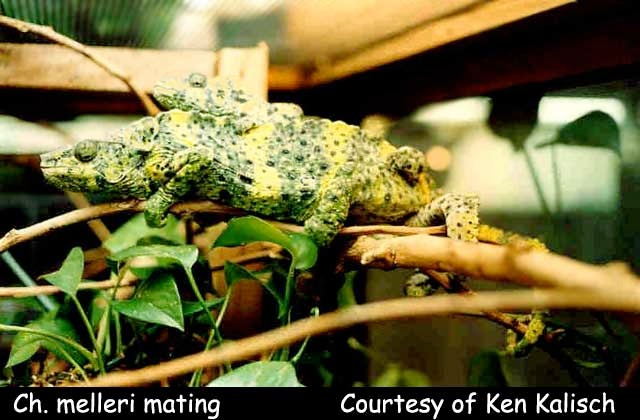
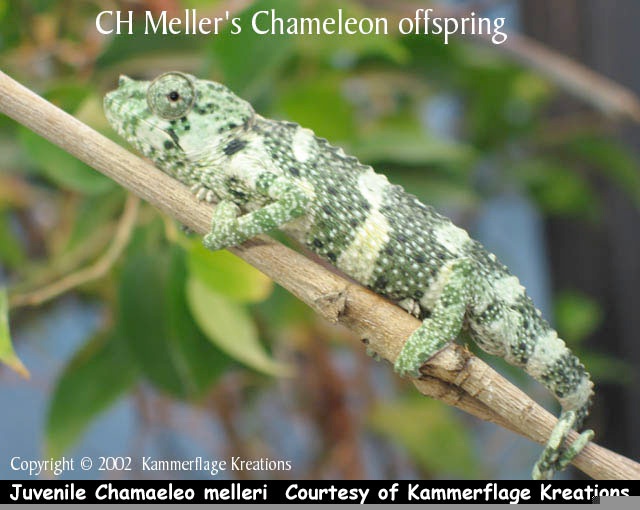
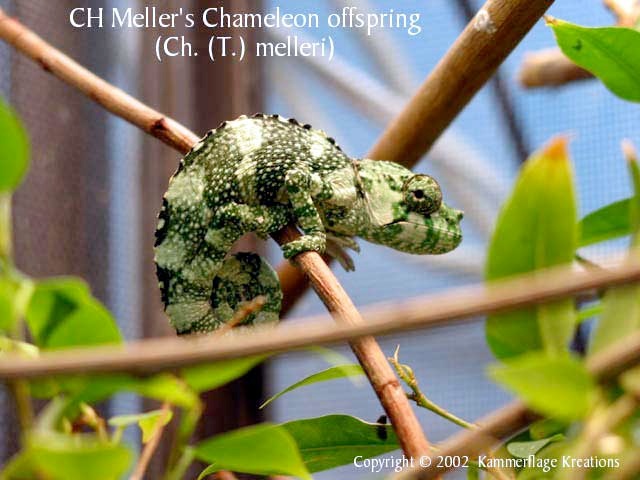
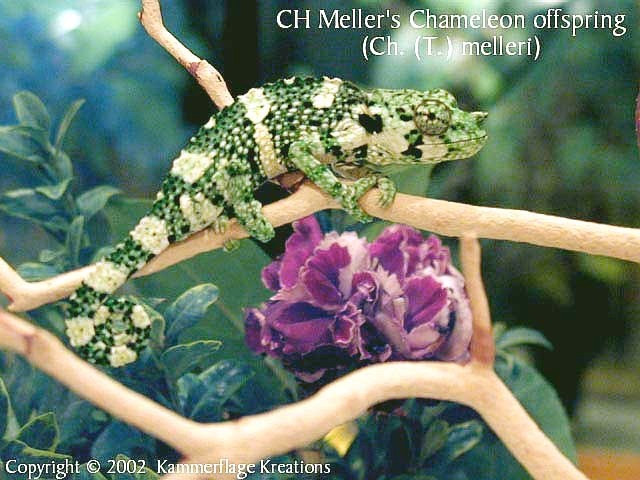
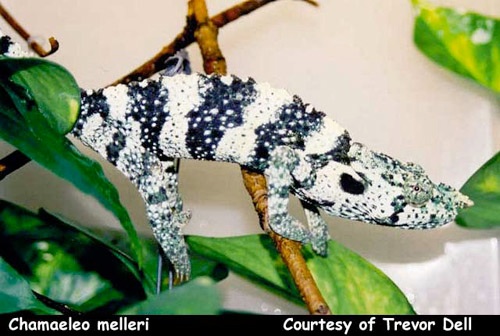
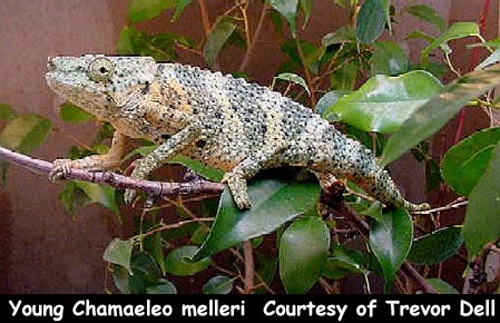
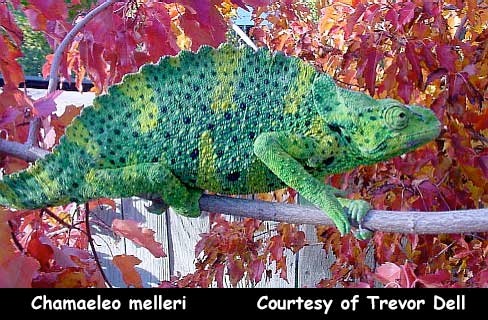
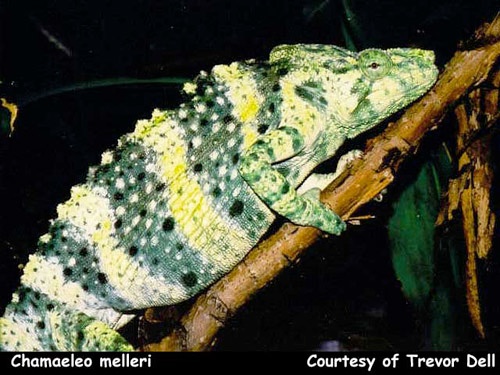

Ken Kalisch

Ken Kalisch has worked with over 40 species of chameleons in the last decade. He was co-editor of the Chameleon information Network, as well as being published by Advanced Vivarium Systems dealing with his experience breeding Calumma parsonii parsonii in captivity. He was the editor of this CHAMELEONS! EZine from March 2002-March 2004.









Join Our Facebook Page for Updates on New Issues:
© 2002-2014 Chameleonnews.com All rights reserved.
Reproduction in whole or part expressly forbidden without permission from the publisher. For permission, please contact the editor at editor@chameleonnews.com
